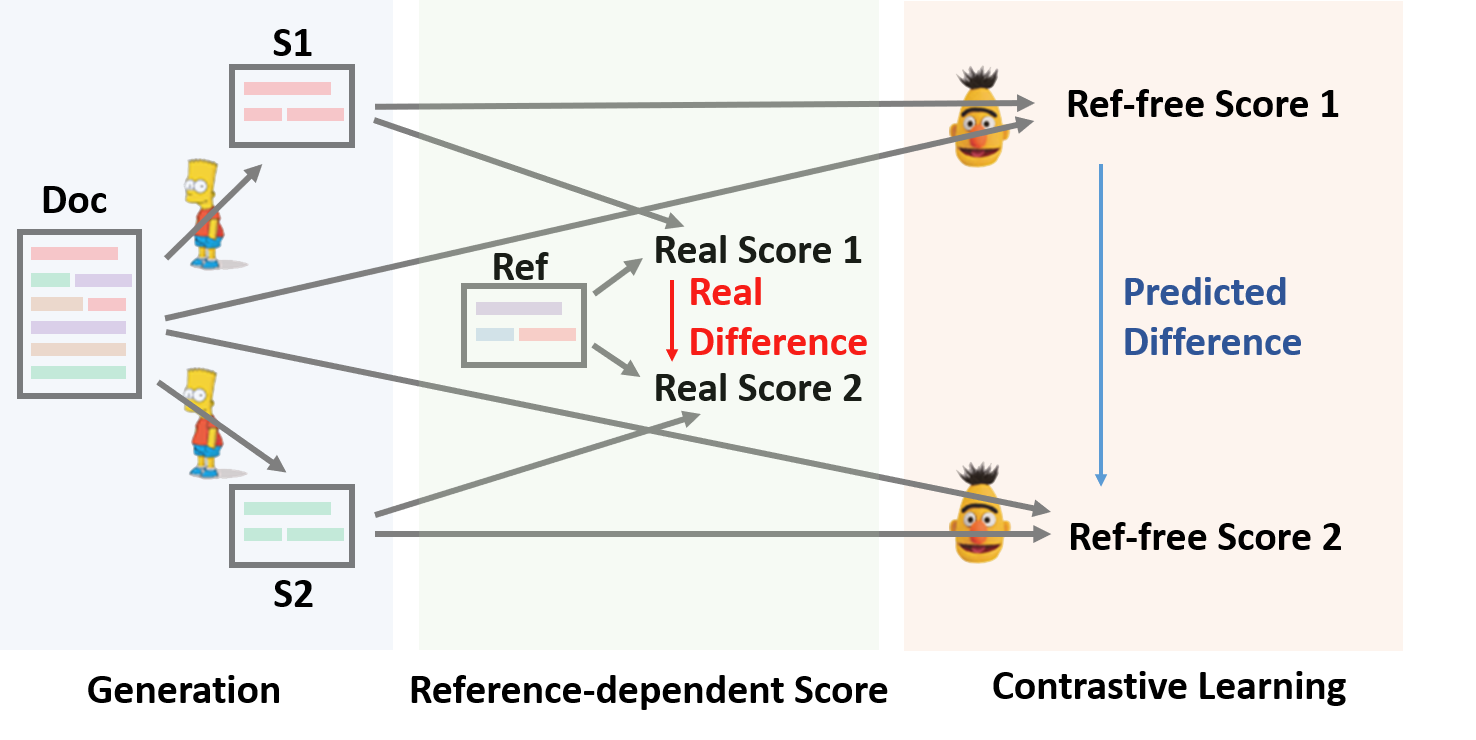SimCLS is a conceptually simple while empirically powerful framework for abstractive summarization, which can bridge the gap between the learning objective and evaluation metrics resulting from the currently dominated sequence-to-sequence learning framework by formulating text generation as a reference-free evaluation problem} (i.e., quality estimation) assisted by contrastive learning.
As shown below, SimCLS framework consists of for two stages: Candidate Generation and Reference-free evaluation, where Doc, S, Ref} represent the document, generated summary and reference respectively.
python3conda create --name env --file spec-file.txtpip3 install -r requirements.txtcompare_mt-> https://github.com/neulab/compare-mt
main.py-> training and evaluation proceduremodel.py-> modelsdata_utils.py-> dataloaderutils.py-> utility functionspreprocess.py-> data preprocessing
Following directories should be created for our experiments.
./cache-> storing model checkpoints./result-> storing evaluation results
We use the following datasets for our experiments.
- CNN/DailyMail -> https://github.com/abisee/cnn-dailymail
- XSum -> https://github.com/EdinburghNLP/XSum
For data preprocessing, please run
python preprocess.py --src_dir [path of the raw data] --tgt_dir [output path] --split [train/val/test] --cand_num [number of candidate summaries]
src_dir should contain the following files (using test split as an example):
test.sourcetest.source.tokenizedtest.targettest.target.tokenizedtest.outtest.out.tokenized
Each line of these files should contain a sample. In particular, you should put the candidate summaries for one data sample at neighboring lines in test.out and test.out.tokenized.
The preprocessing precedure will store the processed data as seperate json files in tgt_dir.
We have provided an example file in ./example.
You can download the preprocessed data for our experiments on CNNDM and XSum.
After donwloading, you should unzip the zip files in this root directory.
You may specify the hyper-parameters in main.py.
To reproduce our results, you could use the original configuration in the file, except that you should make sure that on CNNDM
args.max_len=120, and on XSum args.max_len = 80.
python main.py --cuda --gpuid [list of gpuid] -l
python main.py --cuda --gpuid [list of gpuid] -l --model_pt [model path]
model path should be a subdirectory in the ./cache directory, e.g. cnndm/model.pt (it shouldn't contain the prefix ./cache/).
python main.py --cuda --gpuid [single gpu] -e --model_pt [model path]
model path should be a subdirectory in the ./cache directory, e.g. cnndm/model.pt (it shouldn't contain the prefix ./cache/).
| ROUGE-1 | ROUGE-2 | ROUGE-L | |
|---|---|---|---|
| BART | 44.39 | 21.21 | 41.28 |
| Ours | 46.67 | 22.15 | 43.54 |
| ROUGE-1 | ROUGE-2 | ROUGE-L | |
|---|---|---|---|
| Pegasus | 47.10 | 24.53 | 39.23 |
| Ours | 47.61 | 24.57 | 39.44 |
Our model outputs on these datasets can be found in ./output.
We have also provided the finetuned checkpoints on CNNDM and XSum.
